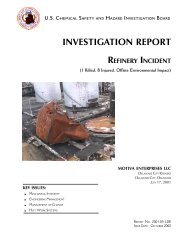CTA Report, Draft 1, ISP Review - US Chemical Safety and Hazard ...
CTA Report, Draft 1, ISP Review - US Chemical Safety and Hazard ...
CTA Report, Draft 1, ISP Review - US Chemical Safety and Hazard ...
You also want an ePaper? Increase the reach of your titles
YUMPU automatically turns print PDFs into web optimized ePapers that Google loves.
K st<br />
(bar-m/sec)<br />
180<br />
160<br />
140<br />
120<br />
100<br />
80<br />
60<br />
40<br />
20<br />
0<br />
117<br />
128<br />
156<br />
165<br />
Cornstarch<br />
SD-52SS + Carbon Black #2<br />
Polyethylene<br />
Pittsburgh Pulverized Coal Dust<br />
Figure 14. Explosion severity of Durite SD-52SS compared with other common combustible dusts.<br />
7.2.2 Prepared Laboratory Samples<br />
Dust that settled in the <strong>CTA</strong> production area was typically a mixture of phenolic resin <strong>and</strong> small<br />
fiberglass fibers. Samples of ground fiberglass <strong>and</strong> phenolic resin were mixed in varying percentages in<br />
the CSB contractor’s laboratory <strong>and</strong> tested. The test results show that as the fiberglass content increased,<br />
the mixtures remain explosible, but explosion severity decreased (Figure 15).<br />
Kst (bar-m/sec)<br />
200<br />
150<br />
100<br />
50<br />
0<br />
0 30<br />
Percent of Fiberglass in Resin/Fiberglass Mixture<br />
50<br />
Figure 15. Explosivity testing results for resin/fiberglass mixtures.<br />
58









